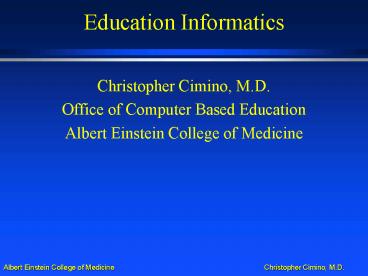Education Informatics - PowerPoint PPT Presentation
1 / 47
Title:
Education Informatics
Description:
Teaching medical informatics. Objectives, tools, faculty development ... Books. Present technology. VCR, Slide projectors, Computer Aided Instruction. Future ... – PowerPoint PPT presentation
Number of Views:52
Avg rating:3.0/5.0
Title: Education Informatics
1
Education Informatics
- Christopher Cimino, M.D.
- Office of Computer Based Education
- Albert Einstein College of Medicine
2
Education Informatics
- Teaching
- Interactions, tools, objectives
- Technology as a tool to teach medicine
- Teaching medical informatics
- Objectives, tools, faculty development
3
How does teaching occur?
- Who is the student?
- Who is the teacher?
- What is being passed between teacher and student?
- What is the role of discovery?
4
Where does teaching occur?
- Lecture vs. small group vs. one-on-one
- Self study vs. tutoring
- Examinations as learning tools
5
What passes between teacher and student
(revisited)
- Communicating knowledge
- Assessing understanding and aptitude
- Changing the student's behavior
- Training skills
- Student as teacher (Dialogue)
6
Where does technology fit in?
- Ancient "technology
- Books
- Present technology
- VCR, Slide projectors, Computer Aided Instruction
- Future technology
- WWW, Distance Learning
7
Examples Computer as a failed teaching tool
- Strengths Communication, Assessment
- Graphics, simulations, item banks
- Weaknesses Role-modeling, Dialogue, Economics
- Emphasis on "self" study and "self" assessment
8
U.C.Davis - Hematology
9
Whole Brain Atlas
10
Cardiax
11
Acid-Base Simulator
12
Simulated Patient
13
DXplain
14
DXplain
15
Examples WWW as a successful teaching tool
- Strengths Communication, Assessment, Work Flow
- Weaknesses Role-modeling, Dialogue
- What makes this a success when computers before
it failed?
16
Merck Manual
17
Abbreviations
18
Clinical Pharmacology
19
Clinical Pharmacology
20
Medical Matrix
21
Electronic Med. Rec. Sys. Project
22
Live ICU Monitoring
23
Cost of educational technology
- Why cost data is difficult to pin down
- Silly accounting tricks
- Real cost saving tricks
24
(No Transcript)
25
(No Transcript)
26
(No Transcript)
27
Evaluation of educational technology
- Education success as measured by science
- Why success is harder to measure in medical
education - Alternate measures of success
28
Organizing principles
- Knowledge
- Skills
- Attitudes
29
Organizing principles
- Mission
- Needs
- Goals
- Objectives
- Solutions
- Evaluation
- Skills
- Knowledge
- Attitudes
- Student Evaluation
- Program Evaluation
30
Needs and Objectives
Need
Goal
Objective
Method
Deficiency
Evaluation
31
Medical Informatics Objectives
- AAMC MSOP Project
- Nursing Informatics Objectives
- Other sources of Informatics Objectives
32
AAMC Informatics Objectives
- Life-long learner
- Clinician
- Educator/Communicator
- Researcher
- Manager
33
AAMC Required Objectives
- Computer literacy
- MEDLINE (Basic Complex)
- Maintain Lit. DB
- Retrieve full text
- Intellectual Property Law
- Evidence Based Medicine
- Navigate a CIS
- Evaluate lab result
- Use decision support tools
- Deal with uncertainty
- Electronic Security
34
AAMC Suggested Objectives
- Educational technologies
- Presentation
- Locate data
- Data collection
- Data analysis
- Data presentation
- Gene sequencing and DB
- Lab automation
- Bibliographic DB structure
- Health care finance management
- CQI
- Cost benefit analysis
- Scheduling tools
35
Comparing Objectives
- Basic computer literacy
- Disagree on details
- Common themes
- Organizing principles
- Divergence
- Required vs. Suggested
36
Teaching and assessing knowledge
- Intellectual property law as an example
- Putting teaching into practice
- Putting assessment into practice
37
Teaching and assessing skills
- Doing a MEDLINE search as an example
- Putting teaching into practice
- Putting assessment into practice
38
Teaching and assessing attitudes
- Regard for patient privacy as an example
- Putting teaching into practice
- Putting assessment into practice
39
Educational technology revisited
- Intellectual property law " as an example
- Doing a MEDLINE search" as an example
- Regard for patient privacy" as an example
40
Cost revisited
- Intellectual property law as an example
- Doing a MEDLINE search as an example
- Regard for patient privacy as an example
41
Benefits of Integrated Education
- Benefits to students
- Benefits to faculty
- Benefits to the institution
42
Obstacles to Integrated Education
- Assigning "credit"
- Logistical problems
- Faculty development
43
Results
44
Student vs. Physician
- Lower cost of student time
- Other measures in place to protect patient
- Captive audience - strong motivating tools
- Needs less sophisticated and more basic
- Perception that technology is good
45
Student Educational Needs
- Administrative - communication, feedback
- Content Learning
- Image atlases (early phase), Self assessment
(early phase), Focused search for information
(later phase) - Learning to use tools
- Bibliographic database, Drug reference, Patient
information system
46
Obstacles
- Economic
- Infrastructure equipment and support
- Licensing
- Policy
- Shared infrastructure and protection of patient
- Envy of staff
- Faculty resistance to using motivational tools
47
More Obstacles
- Access
- Platform dependance
- Slow
- Non-intuitive interface
- Work flow dissonance
- Linkage problems































